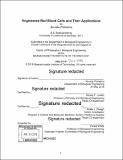Engineered red blood cells and their applications
Author(s)
Pishesha, Novalia.
Download1125967736-MIT.pdf (20.31Mb)
Other Contributors
Massachusetts Institute of Technology. Department of Biological Engineering.
Advisor
Harvey F. Lodish and Hidde L. Ploegh.
Terms of use
Metadata
Show full item recordAbstract
The humble red blood cell (RBC) is the most abundant cell in the human body. Every second, a normal adult generates some 2.5 million RBCs, which subsequently circulate through the blood vessels for a lifespan of 50 or 120 days in mouse and human, respectively. RBCs are also unique in that they are completely enucleated once fully mature. These two characteristics exist as distinct assets for cellular therapy applications utilizing RBCs as a platform, enabling long-lasting availability in vivo and the ability to genetically modify precursor cells without worry of the terminally differentiated progeny carrying any foreign genetic material. The first part of this thesis is devoted to the establishment of methodologies that allow for the covalent attachment of both natural and synthetic cargoes to the surface of red blood cells without compromising its biological properties. This system employs genetic engineering and sortase A, a bacterial transpeptidases. We show that this strategy is able to efficiently engineer both mature mouse and human RBCs in a site-specific and covalent manner. The next portion of this work describes how these established methodologies can be mixed and matched according to the diverse needs of engineered RBC applications. We provide a proof of concept that utilizes engineered RBCs to prolong prophylactic protection against deadly toxins. By expressing chimeric proteins of single domain antibodies (VHHs) against botulinum neurotoxin A (BoNT/A) with RBC-specific proteins, we demonstrated that mouse RBCs expressing anti-BoNT/A VHHs can provide resistance up to 10,000 times the lethal dose (LD₅₀) of BoNT/A. We validate this finding by repeating our results in a human RBC culture system that we have improved to achieve 90% enucleation, illustrating the broad translatability of our strategy for therapeutic applications. Finally, drawing upon knowledge that the body clears 2.5 millions RBCs every second to maintain homeostasis, we use sortase to attach disease-associated autoantigens to genetically engineered and to unmodified red blood cells (RBCs). Such modified RBCs masquerade with these autoantigens as their own, and hijack the non-inflammatory nature of the RBC clearance pathway to promote tolerance to their carried payload. We show that this blunts the immune contribution of major subsets of immune effector cells (B cells, CD4+ and CD8+ T cells) in an antigen-specific manner. Transfusion of RBCs expressing self-antigen epitopes alleviates and even prevents signs of disease in an experimental system for autoimmune encephalomyelitis, and also maintains normoglycemia in a mouse model of type 1 diabetes, highlighting the potential of engineered RBCs for treating autoimmune diseases. Taken together, the results of applying our engineered RBCs in areas of both acute infectious and toxic agents, as well as for longer-term chronic and autoimmune diseases, hint at the tremendous potential of this system, and we have only begun to scratch the surface.
Description
Thesis: Ph. D., Massachusetts Institute of Technology, Department of Biological Engineering, 2018 Cataloged from PDF version of thesis. Includes bibliographical references.
Date issued
2018Department
Massachusetts Institute of Technology. Department of Biological EngineeringPublisher
Massachusetts Institute of Technology
Keywords
Biological Engineering.